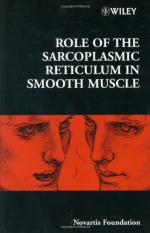|
This section contains 414 words (approx. 2 pages at 300 words per page) |

|
Smooth muscle gets its name because there are no striations visible in the muscle tissue. In other muscles, dark and light bands are seen under microscopic examination. Nevertheless, smooth muscles do contain different types of filaments. Thick filaments are called myosin and thin filaments are called actin. These filaments are present in other types of muscles, such as striated muscle, in addition to smooth muscle.
The cells of a smooth muscle are long and spindle-shaped. In hollow organs they tend to be arranged in bundles in an outer layer that is oriented with the long axis of the organ, and in a circular pattern around the inner surface.
Smooth muscles are found in internal organs. Examples include the uterus, the bronchi of the lungs, the bladder, and the walls of blood vessels.
The myosin and actin filaments are designed to slide against each other. In smooth...
|
This section contains 414 words (approx. 2 pages at 300 words per page) |

|


